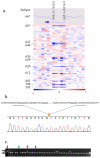Association of a germ-line copy number variation at 2p24.3 and risk for aggressive prostate cancer
- PMID: 19258504
- PMCID: PMC2743179
- DOI: 10.1158/0008-5472.CAN-08-3151
Association of a germ-line copy number variation at 2p24.3 and risk for aggressive prostate cancer
Abstract
We searched for deletions in the germ-line genome among 498 aggressive prostate cancer cases and 494 controls from a population-based study in Sweden [CAncer of the Prostate in Sweden (CAPS)] using Affymetrix SNP arrays. By comparing allele intensities of approximately 500,000 SNP probes across the genome, a germ-line deletion at 2p24.3 was observed to be significantly more common in cases (12.63%) than in controls (8.28%); P = 0.028. To confirm the association, we genotyped this germ-line copy number variation (CNV) in additional subjects from CAPS and from Johns Hopkins Hospital (JHH). Overall, among 4,314 cases and 2,176 controls examined, the CNV was significantly associated with prostate cancer risk [odds ratio (OR), 1.25; 95% confidence interval (95% CI), 1.06-1.48; P = 0.009]. More importantly, the association was stronger for aggressive prostate cancer (OR, 1.31; 95% CI, 1.08-1.58; P = 0.006) than for nonaggressive prostate cancer (OR, 1.19; 95% CI, 0.98-1.45; P = 0.08). The biological effect of this germ-line CNV is unknown because no known gene resides in the deletion. Results from this study represent the first novel germ-line CNV that was identified from a genome-wide search and was significantly, but moderately, associated with prostate cancer risk. Additional confirmation of this association and functional studies are warranted.
Figures

Similar articles
-
Genome-wide copy-number variation analysis identifies common genetic variants at 20p13 associated with aggressiveness of prostate cancer.Carcinogenesis. 2011 Jul;32(7):1057-62. doi: 10.1093/carcin/bgr082. Epub 2011 May 5. Carcinogenesis. 2011. PMID: 21551127 Free PMC article.
-
Germ-line sequence variants of PTEN do not have an important role in hereditary and non-hereditary prostate cancer susceptibility.J Hum Genet. 2011 Jul;56(7):496-502. doi: 10.1038/jhg.2011.48. Epub 2011 Jun 2. J Hum Genet. 2011. PMID: 21633361 Free PMC article.
-
Sequence variants at 22q13 are associated with prostate cancer risk.Cancer Res. 2009 Jan 1;69(1):10-5. doi: 10.1158/0008-5472.CAN-08-3464. Cancer Res. 2009. PMID: 19117981 Free PMC article.
-
Screening for familial and hereditary prostate cancer.Int J Cancer. 2016 Jun 1;138(11):2579-91. doi: 10.1002/ijc.29949. Epub 2016 Feb 5. Int J Cancer. 2016. PMID: 26638190 Review.
-
Germline copy number variation and cancer risk.Curr Opin Genet Dev. 2010 Jun;20(3):282-9. doi: 10.1016/j.gde.2010.03.005. Epub 2010 Apr 8. Curr Opin Genet Dev. 2010. PMID: 20381334 Review.
Cited by
-
DeviCNV: detection and visualization of exon-level copy number variants in targeted next-generation sequencing data.BMC Bioinformatics. 2018 Oct 16;19(1):381. doi: 10.1186/s12859-018-2409-6. BMC Bioinformatics. 2018. PMID: 30326846 Free PMC article.
-
copy number variation analysis in familial BRCA1/2-negative Finnish breast and ovarian cancer.PLoS One. 2013 Aug 13;8(8):e71802. doi: 10.1371/journal.pone.0071802. eCollection 2013. PLoS One. 2013. PMID: 23967248 Free PMC article.
-
Germline DNA copy number variations as potential prognostic markers for non-muscle invasive bladder cancer progression.Oncol Lett. 2017 Jul;14(1):1193-1199. doi: 10.3892/ol.2017.6233. Epub 2017 May 24. Oncol Lett. 2017. PMID: 28693295 Free PMC article.
-
Germline DNA copy number variation in familial and early-onset breast cancer.Breast Cancer Res. 2012 Feb 7;14(1):R24. doi: 10.1186/bcr3109. Breast Cancer Res. 2012. PMID: 22314128 Free PMC article.
-
Blood and tissue biomarkers in prostate cancer: state of the art.Urol Clin North Am. 2010 Feb;37(1):131-41, Table of Contents. doi: 10.1016/j.ucl.2009.11.006. Urol Clin North Am. 2010. PMID: 20152526 Free PMC article. Review.
References
-
- Sebat J, Lakshmi B, Troge J, et al. Large-scale copy number polymorphism in the human genome. Science. 2004;305:525–8. - PubMed
-
- Iafrate AJ, Feuk L, Rivera MN, et al. Detection of large-scale variation in the human genome. Nat Genet. 2004;36:949–51. - PubMed
-
- Tuzun E, Sharp AJ, Bailey JA, et al. Fine-scale structural variation of the human genome. Nat Genet. 2005;37:727–32. - PubMed
-
- Conrad DF, Andrews TD, Carter NP, Hurles ME, Pritchard JK. High-resolution survey of deletion polymorphism in the human genome. Nat Genet. 2006;38:75–81. - PubMed
Publication types
MeSH terms
Grants and funding
LinkOut - more resources
Full Text Sources
Other Literature Sources
Medical
Miscellaneous

